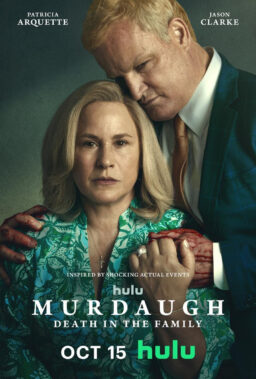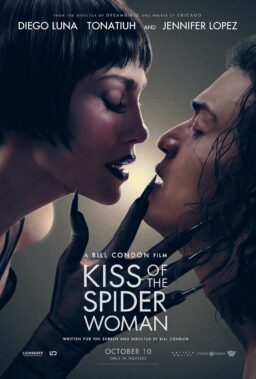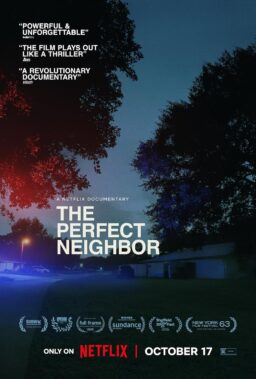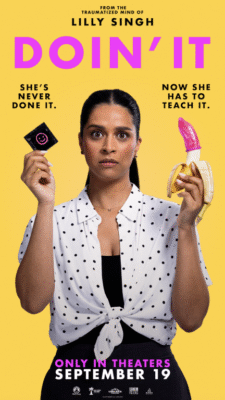Ebert’s Best Film Lists 1967 – present
1. “Monster“
The performance of the year, in the film of the year. Charlize Theron plays Aileen Wuornos, a prostitute who was executed in Florida for the murders of seven men. The film portrays her as a woman so damaged in early life, so beaten down by daily existence, that although her crimes are not forgivable, her actions are like the flailings of a wounded animal.
Theron, now 28, has been known until now as the tall, attractive star of mid-level entertainments like “The Italian Job” and “Men of Honor.” Nothing in her career prepares us for this astonishing performance, in a film she developed with writer-director Patty Jenkins. She uses various strategies to look older, heavier, more weathered, but we simply forget to think about them because her character is real, convincing, and focused at every moment with a scary intensity.
Christina Ricci co-stars, as a naïve young woman who becomes Aileen’s lover and gives her for the first time the hope of leading a normal life. But both women are disconnected from reality, and their search for happiness leads to a serial killing spree in which the death of a well-meaning man played by Scott Wilson is unbearably painful. We are told to hate the sin but love the sinner, and “Monster” is a luminous work of empathy, showing us a woman whose destiny was already sealed as a battered child.
2. “Lost in Translation“
Sofia Coppola wrote and directed this winsome, bittersweet film about two lonely people in the middle of the night in Tokyo. Bill Murray is a movie star in town to make commercials. Scarlett Johansson plays the new wife of a young photographer who is dazzled by his own success and drifting away from her. They meet in the hotel bar and begin a conversation that lasts several days. Ancient movie conventions lead us to suspect they will have an affair, but the movie is deeper and wiser than that — and shows that, although the possibility of sex exists between them, their needs are much harder to fill: They need someone to talk with about lifetimes that seem to be drifting away from their dreams.
Murray gives his finest performance, carefully controlling his comic gift so that he plays a man who (ital) could (unital) be funny, but is off-duty. Johansson, who brings enormous reserves of presence and patience to the role, is also magical in another 2003 film, “The Girl with a Pearl Earring,” where again she plays a woman who is the focus of an artist’s loneliness.
3. “American Splendor“
When a Cleveland file clerk uses his mundane existence as the inspiration for a comic book, he achieves unlikely fame, a berth on the Letterman show, and a following that includes other wage slaves who find daily office life to be as filled with rage and excitement as any action picture. But how can a film about Harvey Pekar reconcile truth and fiction, comic art and daily reality? Co-directors Shari Springer Berman and Robert Pulcini meet the challenge by combining all of the elements.
Part of their film is in the form of an animated comic strip (based on drawings by R. Crumb). Part is a documentary showing the real Harvey Pekar, his wife Joyce Brabner and his co-workers. And part is a fiction film starring Paul Giamatti as Harvey and Hope Davis as Joyce.
The real people and the actors are sometimes on screen together, creating an uncanny tension between life and performance. The movie is funny and brave, the story of heroism in the real life of an anti-hero who is in a bad mood most of the time, and who rejects an offer to host a talk show because he doesn’t want to risk his civil service pension.
4. “Finding Nemo“
I usually sit toward the back of the theater, but during “Finding Nemo” I wanted to sit closer, to immerse myself in the underwater beauty of the film’s graceful animation. The story is lots of fun (how in the world can a fish escape from an aquarium and get across the highway and back into the sea?), but the most distinctive accomplishment of the Pixar production is its visual artistry. Water is often dealt with in animation as if it is simply transparent, except for bubbles. The artists of “Finding Nemo” have uncanny success in suggesting that their characters are actually swimming in the sea; carefully modulated color densities suggest actual less water between a character and the audience. The story is well-told, but the telling gains immensely from the visuals.
5. “Master and Commander: The Far Side of the World“
Patrick O’Brien’s characters inspire a grand and glorious spectacle in the tradition of the best seafaring epics. Russell Crowe, always convincing in a performance that sidesteps the obvious temptations to overact, plays the captain of a British warship contending with the French for control of South American waters. His best friend is the ship’s surgeon, played by Paul Bettany, and their conflicting views about war and life provide a counterpoint to the action scenes. Not simply a swashbuckler, although it has rousing sea battles, but an intelligent movie about men tested by the sea.
Director Peter Weir mounts an impressive production, seamlessly combining real ships, models and tank work into a sobering portrait of how deadly and beautiful sea warfare was in the age of sail.
6. “Mystic River“
Clint Eastwood’s drama is a brooding exploration of ancient evils and their abiding cost. His film, based on Brian Helgeland’s adaptation of Dennis Lehane’s novel, shows us three friends for whom childhood is forever marred by a tragedy. Now, as adults, Sean Penn’s daughter has been murdered, Tim Robbins is a possible suspect, and Kevin Bacon is the cop on the case. This could have been a crime thriller or a police procedural, but Eastwood turns it toward almost Shakespearean tragedy, as each man’s character plays out in his fate. Eastwood has directed some two dozen films, some good, some ordinary; in this one and “The Unforgiven” he finds greatness.
7. “Owning Mahowny“
Philip Seymour Hoffman’s inward, focused performance is the key to this movie about a gambling obsession. He plays a Toronto bank clerk in hock to his bookie, who begins to steal money and eventually loses millions in Atlantic City and Vegas. The film, directed by Richard Kwietniowski and inspired by a true story, avoids the artificial highs and lows of many gambling movies and shows Hoffman burrowing straight ahead, his eyes rarely lifted from the action, as if under a hypnotic spell. John Hurt is splendid as the casino boss who thought he knew all about compulsive gambling, but becomes fascinated by this man’s overwhelming need to play — and lose.
8. “The Son“
Not a film many readers are likely to have heard about, but a film that cannot be forgotten by anyone who saw it. “It needs no insight or explanation,” I wrote in my review. “It sees everything and explains all. It is as assured and flawless a telling of sadness and joy as I have ever seen.” Directed by the brothers Dardenne, Jean-Pierre and Luc, it tells of a Belgian carpenter who supervises apprentices. One day a candidate is brought to him. At first he rejects the boy, but then he reconsiders and accepts him, and we discover something that the carpenter knows about the boy — a secret that leads to scenes where sudden violence seems barely beneath the surface.
All the action is in terms of the carpentry work, and there is a sequence in a lumber yard that uses sound and timing to make sudden physical disaster seem imminent.
9. “Whale Rider“
What a splendid film for the entire family! Keisha Castle-Hughes stars in a sparkling performance as Paikea, a teenager who would be next in line to lead her tribe — if she were not a girl. Niki Caro’s film is set in a present-day Maori village in New Zealand, where legends are still preserved. Paikea’s father has no wish to lead the tribe after a tragedy, and leaves the country. Her grandfather loves her, but is locked into ancient traditions. As he tries to train one of the hapless village boys, Paikea studies on her own, and the climax is thrilling and heart-warming. This year’s “Bend It Like Beckham.”
10. “In America“
Inspired by Irish director Jim Sheridan’s own immigration to America in the 1980s, it tells the story of a family lives in poverty in a New York tenement and struggles to survive after the loss of a son. Paddy Considine plays the sometimes despairing father, Samantha Morton is heroic as the mother, Sarah Bolger steals the show as the older sister–and downstairs, a fearsome African artist (Djimon Hounsou) reveals a hidden gentleness. I’ve seen a lot of movies about the immigrant experience, but this one lives outside the rules, absorbing us in the family’s struggle to survive.
Special Jury Prizes
At most film festivals, the jury picks a grand prize, and then awards a “jury prize” to a film they hold in the same high esteem. The following films are not my “runners-up,” but rank in my esteem with the Top Ten. It was a very good year for the movies, and a perfectly respectable Best Films list could be composed from these titles, ranked alphabetically:
“All the Real Girls” is David Gordon Green’s second film after the astonishing “George Washington,” and confirms his status as a filmmaker of poetic originality. Once again he eavesdrops on the lives or ordinary people doing ordinary things — not in an ordinary way, but expressed through a heightened and gentle sensibility.
“The Barbarian Invasions,” by Denys Arcand of Quebec, revisits the characters in his “The Decline of the American Empire” (1987). Now the Falstaffian left-wing professor Remy (Remy Girard) lies near death, and his former wife and estranged son are the unlikely instruments for a reunion of old friends and old (and current!) lovers, who celebrate his zest for life, and their own.
“Better Luck Tomorrow.” Justin Lin’s comedy of manners onsiders a group of affluent Asian-American kids in high school, who get straight As and supplement their incomes by selling term papers and eventually escalating to drugs and murder. The film is about a value system that places success above morality. Lurking beneath the close surface observation is the implication that their behavior and strategies have perfectly positioned them to take over from the fallen leaders of Enronism.
“Elephant.” Gus Van Sant considers a day in the life of a high school very much like Columbine, using an objective narrative and visual style that records the horror of a massacre but doesn’t let us off the hook with potted psychological motivations. The killers are so detached they seem to be playing a video game — one that counts points in terms of real lives for which they have no feeling.
“Girl With a Pearl Earring” is Peter Webber’s sensuous meditation on artistic inspiration, starring Scarlett Johansson in the second of her great performances this year, as a poor girl who is employed as a maid in the home of the Dutch master Vermeer (Peter Firth) and not only inspires a famous painting but also makes an unmistakable artistic and emotional connection with him — which the rigid social code of the time prevents them from acknowledging.
“House of Sand and Fog.” A young woman (Jennifer Connelly) fails to pay the real estate taxes on the home she inherited, and an Iranian immigrant (Ben Kingsley) buys it an auction. Both are poor, both need the house, both see it as the key to their futures. The deputy (Ron Eldard) who evicts the woman becomes involved with her, and his lack of judgment has tragic consequences. Directed by Vadim Perelman, himself an immigrant, from the novel by Andre Dubus III.
“Kill Bill, Volume 1” is Quentin Tarantino in virtuoso mode, giving us a martial arts picture that is heavy on storytelling, light on story. The film is all kinetic energy, visual conceit, production design, and performances focused to a razor’s edge but with only the most rudimentary motivation or character development. It is a tribute to Uma Thurman and the other cast members that they are able to bring presence and substance to characters who have been written with rubber stamps.
“The Man on the Train.” Another delight from the French director Patrice Leconte, who begins with an accidental meeting between a retired schoolteacher (Jean Rochefort) and an aging bank robber (played by the French rock legend Johnny Hallyday). Their chance conversation ends with the robber agreeing to use the teacher’s guest room, and as their talks continue, it becomes clear that each envies the life of the other. Leconte and writer Claude Klotz have devised an ending of bold poetic fantasy.
“May.” Hated by a lot of critics, but, yes, I think it’s good enough for this list. A truly strange horror film about a disturbed young woman and the way her obsessions lead to tragic weirdness. Oddly moving, with a title performance by Angela Bettis that stirs and touches like young Sissy Spacek in “Carrie.”
“Matchstick Men.” Ridley Scott’s complex portrait of a con man (Nicholas Cage) who inhabits three story threads, all adequate to carry a film: (1) He’s involved in complicated cons with his longtime partner (Sam Rockwell). (2) He has a smorgasbord assortment of behavioral disorders, ranging from agoraphobia to obsessive-compulsive behavior to Tourette’s Syndrome, that make it very hard to be as coordinated con man. (3) He meets the teenage daughter (Alison Lohman) he never knew he had. The epilogue strikes a perfect note, explaining who the characters are and, in a way, why.
“Northfork.” The spare, stark, dreamy fantasy centering around a town being flooded by the waters of a dam. As men in black evict the residents, angels visit to comfort a dying boy, and enigmatic conversations take place against a backdrop of vast empty sadness. Made by the Polish brothers (“Twin Falls, Idaho”), who create an epic whose scope underlines its desolation.
“Nowhere in Africa.” Caroline Link won the Oscar for best foreign film for this engaging story of a German Jewish family that escapes Hitler to settle on a farm on East Africa, where the young daughter feels at home while her parents make their own shifting accommodations.
“The Russian Ark.” A stupendous technical achievement by Aleksandr Sokurov and his cinematographer, Tilman Buttner, who choreograph a single shot that lasts for the entire length of the film, as the point of view moves through the Hermitage museum in St. Petersburg and characters materialize to represent centuries of Russian history.
“Safe Conduct.” Bertrand Tavernier’s ambitious, passionate story about French filmmakers who continued to work under the Nazi occupation, and to a remarkable degree made the films they wanted to make. A film about film, made with insight and sympathy.
Best Documentaries
In alphabetical order: “Amandla!” was a stirring doc about the role played by music in bringing change to South Africa. “Biggie and Tupac,” directed by one-man investigative team Nick Broomfield, solves their murders and names their killers, at least to his own satisfaction. “Capturing the Friedmans” used the family’s own home movies to help tell the story of a father and brother both charged with molesting minors. “The Fog of War,” which opens in 2004, was Errol Morris’s extraordinary interview with Robert McNamara, who speaks frankly and often regretfully about his role as an American soldier and later Secretary of Defense. “Rivers and Tides” was the haunting doc about Andy Goldsworthy, an artist who creates temporary works out of found objects in nature, and then watches as nature destroys them.
“Spellbound” followed eight finalists on their way to a showdown in the National Spelling Bee. “Stevie” was Steve (“Hoop Dreams“) James’ heartbreaking return to the life of a kid he met in the Big Brother program; that life has not gone well. “The Stone Reader,” by Mark Moskowitz, traced his obsession with the author of a highly-praised 1972 novel, “The Stones of Summer.” He succeeds in tracking down Dow Mossman, in a delightful work in praise of readers and writers. “Tupac Resurrection” was a biopic about Tupac Shakur, seemingly narrated from beyond the grave by the murdered rap star. And “Winged Migration” follows birds on their exhausting odysseys from summer to winter, with cameras that establish a startling intimacy with the subjects.
Honorary Mention
To Jack Angstreich, Eric Chadbourne, Harvey Schwartz, Roberta Hill and Bill Heidbreder. Who are they? The compulsive moviegoers in the documentary “Cinemania,” who spend every waking minute of every day going to the movies. It is very likely all five of them have seen every title on my lists.











